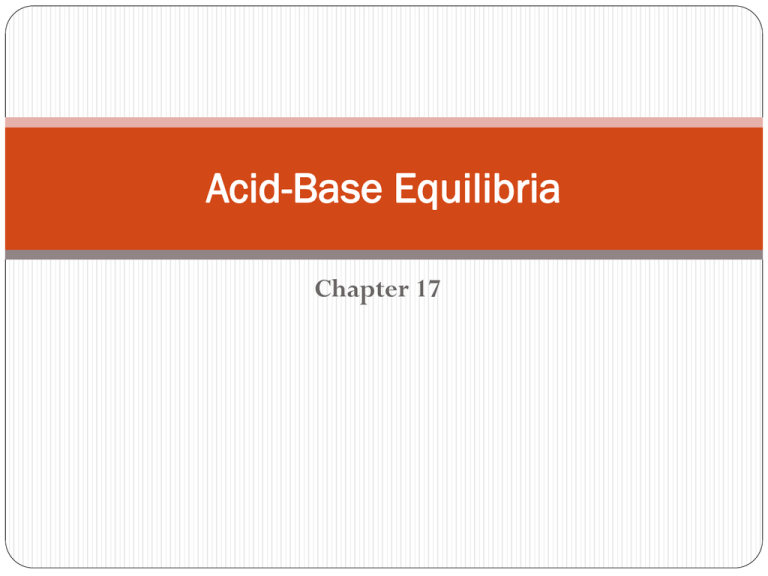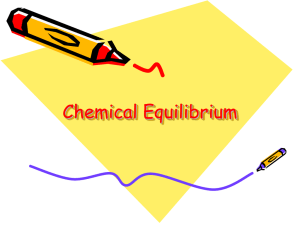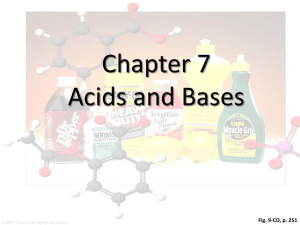Acid-Base Equilibria
advertisement

Acid-Base Equilibria Chapter 17 The simplest acid–base equilibria are those in which a weak acid or a weak base reacts with water. We can write an acid equilibrium reaction for the generic acid, HA. HA(aq) + H2O(l) H3O+(aq) + A-(aq) Acetic acid is a weak acid. It reacts with water as follows: HC2H3O2(aq) + H2O(l) H3O+(aq) + C2H3O2-(aq) Here A from the previous slide = C2H3O2-(aq) The equilibrium constant for the reaction of a weak acid with water is called the acid-ionization constant (or aciddissociation constant), Ka. Ka H O 3 A HA Liquid water is not included in the equilibrium constant expression. In order of decreasing Ka: HF Ka 6.8 × 10-4 Highest pH HCN HNO2 HC2H3O2 4.5 × 10-4 HC2H3O2 1.7 × 10-5 HNO2 HCN 4.9 × 10-10 HF Lowest pH Calculations with Ka Given the value of Ka and the initial concentration of HA, you can calculate the equilibrium concentration of all species. Given the value of Ka and the initial concentration of HA, you can calculate the degree of ionization and the percent ionization. Given the pH of the final solution and the initial concentration of HA, you can find the value of Ka and the percent ionization. We can be given pH, percent or degree ionization, initial concentration, and Ka. From pH, we can find [H3O+]. From percent or degree ionization, we can find Ka. Using what is given, we can find the other quantities. Sore-throat medications sometimes contain the weak acid phenol, HC6H5O. A 0.10 M solution of phenol has a pH of 5.43 at 25°C. a. What is the acid-ionization constant, Ka, for phenol at 25°C? b. What is the degree of ionization? HC6H5O(aq) + H2O(l) H3O+(aq) + C6H5O-(aq) Initial Change Equilibrium We were told that pH = 5.43. That allows us to find [H3O+] = = x = [C6H5O-]. Now we find [HC6H5O] = 0.10 – x = Finally, we write the expression for Ka and substitute the concentrations we now know. The degree of ionization is the ratio of ionized concentration to original concentration: Degree of ionization x 0.100 Degree of ionization 3.7 10 6 0.10 3.7 10 5 Percent ionization is the degree of ionization × 100%: Percent ionization = 3.7 x 10-3% or 0.0037% Simplifying Assumption for Acid and Base Ionizations The equilibrium concentration of the acid is most often ([HA]0 – x). If x is much, much less than [HA]0, we can assume that subtracting x makes no difference to [HA]: ([HA]0 – x) = [HA]0 This is a valid assumption when the ratio of [HA]0 to Ka is > 103. If it is not valid, you must use the quadratic equation to solve the problem. Para-hydroxybenzoic acid is used to make certain dyes. What are the concentrations of this acid, of hydronium ion, and of parahydroxybenzoate ion in a 0.200 M aqueous solution at 25°C? What is the pH of the solution and the degree of ionization of the acid? The Ka of this acid is 2.6 × 10-5. We will use the generic formula HA for para-hydroxybenzoic acid and the following equilibrium: HA + H2O H3O+ + A- HA(aq) + Initial Change Equilibrium H2O(l) H3O+(aq) + A-(aq) Polyprotic Acids A polyprotic acid has more than one acidic proton—for example, H2SO4, H2SO3, H2CO3, H3PO4. These acids have successive ionization reactions with Ka1, Ka2, . . . The next example illustrates how to do calculations for a polyprotic acid. Tartaric acid, H2C4H4O6, is a diprotic acid used in food products. What is the pH of a 0.10 M solution? What is the concentration of the C4H4O62 ion in the same solution? Ka1 = 9.2 104; Ka2 = 4.3 105. First, we will use the first acid-ionization equilibrium to find [H+] and [HC4H4O6-]. In these calculations, we will use the generic formula H2A for the acid. Next, we will use the second acid-ionization equilibrium to find [C4H4O62-]. H2A(aq) + Initial Change Equilibrium H2O(l) H3O+(aq) + HA-(aq) We eliminate physically the negative impossible value because to have a negative At the end of the first acid ionization concentrat Now we ionization it is concentrat equilibriu m, the ions are use these for the second acid equilibriu m. ion. HA-(aq) + Initial Change Equilibrium H2O(l) H3O+(aq) + A2-(aq) Base-Ionization Equilibrium The simplest acid–base equilibria are those in which a weak acid or a weak base reacts with water. We can write a base equilibrium reaction for the generic base, B. B(aq) + H2O(l) HB+(aq) + OH-(aq) Ammonia is a weak base. It reacts with water as follows: NH3(aq) + H2O(l) NH4+(aq) + OH-(aq) Here the generic B from the previous slide is NH3(aq). The equilibrium constant for the reaction of a weak base with water is called the base-ionization constant, Kb. HB O H Kb B Liquid water is not included in the equilibrium constant expression. Writing Kb Reactions The bases in Table 16.2 (previous slide) are nitrogen bases; that is, the proton they accept adds to a nitrogen atom. Next we’ll practice writing the Kb reactions. Ammonium becomes ammonium ion: NH3+ H2O NH4+ + OHEthylamine becomes ethyl ammonium ion: C2H5NH2 + H2O C2H5NH3+ + OH- Dimethylamine becomes dimethylammonium ion: (CH3)2NH2 + H2O (CH3)2NH3+ + OHPyridine becomes pyridinium ion: C5H5N+ H2O C5H5NH+ + OHHydrazine becomes hydrazinium ion: N2H4+ H2O N2H5+ + OH- We can be given pH, initial concentration, and Kb. From the pH, we can find first [H3O+] and then [OH-]. Using what is given, we can find the other quantities. We can also use a simplifying assumption: When [B]0 / Kb > 103, the expression ([B]0 – x) = [B]0. Aniline, C6H5NH, is used in the manufacture of some perfumes. What is the pH of a 0.035 M solution of aniline at 25°C? Kb= 4.2 × 10-10 at 25°C. We will construct an ICE chart and solve for x. C6H5H(aq) + H2O(l) C6H5NH+(aq) + OH-(aq) Initial Change Equilibrium We are told that Kb = 4.2 × 10-10. That allows us to substitute into the Kb expression to solve for x. The question asks for the pH:









